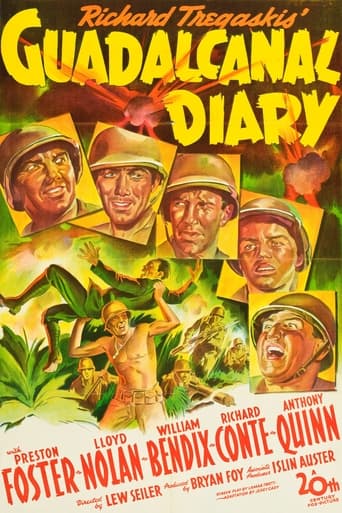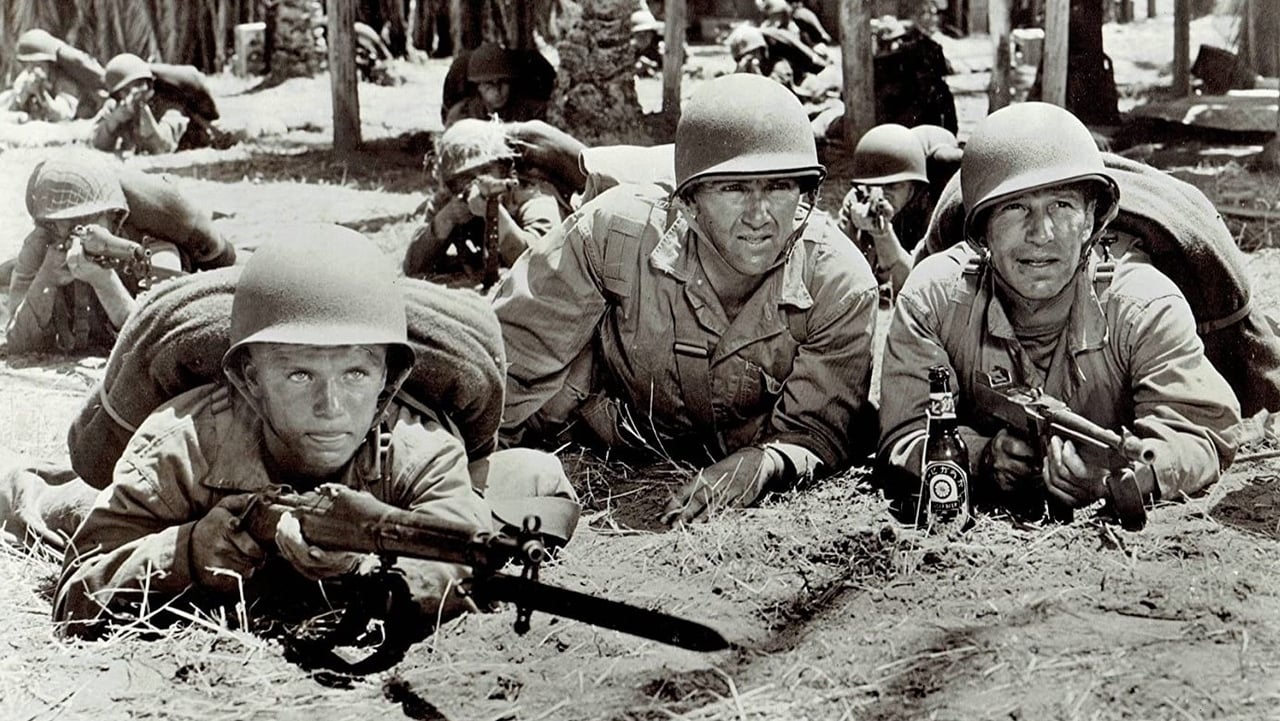SimonJack
"Guadalcanal Diary" came out smack dab in the middle of the U.S. fighting in WW II. It was made the year after the actual events portrayed in the film. It's based on a book by the same title, written by Richard Tregaskis. He was a war correspondent who covered the taking of Guadalcanal. One can appreciate this film for its reality and straightforward portrayal as written by the author. This was before Hollywood began to fantasize and over dramatize many of the battles and the war action in later films. The narration is a nice touch, with an actor representing the author who tells us about the story as it unfolds. Others have commented on the excellent cast. All actors did a superb job in portraying a bunch of American Marines who hadn't yet seen war and had no idea of what to expect. Onboard ship somewhere in the South Pacific, we see the men lying around and waiting and wondering. The usual hijinks and talk about girls back home, baseball and family take place. Finally, we see the naval bombardment, the beach landing unchallenged by the Japanese, and then the battles as the Marines move inland and route the enemy. Some other nice touches of realism are in the lines by various actors. Lloyd Nolan as Sgt. Hook Malone cautions the men about not going after Japanese souvenirs because they could be booby-trapped. Preston Foster as the chaplain, Father Donnelly, is a paternal figure for the men who will be right beside them in the first wave to hit the beach. Col. Grayson tells the men it will be a tedious, tough job to route the enemy, because the Japanese soldiers are tough. We see ordinary men fighting, getting wounded, and being killed – on both sides. When Army replacements arrive, the Marines welcome them. The battle action sequences are very realistic, and the movie makers must have received actual film footage of the naval bombardment from the Navy. It's very impressive. Some people quibble about racial slurs. We must remember that this film is an accurate portrayal of what really happened, and what it was like for and with our troops. Later modern sanitized films were scripted to be politically correct, but in the process they sacrificed some of the truth and realism of the times and events. Movie companies today put disclaimers on older films for various portrayals, especially regarding race and culture. They point out the inappropriate language, behavior or treatment of some people in the older films, by today's standards. And, they note that to expunge or change the film to eliminate such material after the fact, would be a denial of the facts and truth that such things had occurred in history as portrayed. Therefore, they have significant historical value in educating society about those times and behaviors of the past. This film is a must for any serious war film collection.
tavm
For this day, Veterans Day, I decided to watch this movie-among many provided by Hulu by way of IMDb-that depicts the events of the Marine soldiers as they fight the Japanese soldiers in the title area. Quite a few actors I recognized here like Anthony Quinn, Lionel Stander, Lloyd Nolan, and William Bendix. Quinn's the Hispanic with two girlfriends at home, Stander's the buddy of Bendix, Nolan's the gunnery sergeant, and Bendix is just a grunt from Flatbush (that's Brooklyn to the rest of us). Stander with Bendix provide some good humor along with Nolan who also provides his compassionate authority to Bendix, Quinn, and the rest. Bendix himself makes a compelling speech about just wanting to go home when everyone is inside a foxhole avoiding several bombs. Quinn also has a great scene as a lone survivor of his first platoon when he swims away from the "Japs", which is what they were referred to at the time. There's also lots of relaxing scenes of people reading letters and some nice naturalistic singing and dancing sequences that provide much needed lighter moments before the somber (to me) war scenes. At only 93 minutes, there's not too much detail on many of the main characters but what there is is sufficient and the narration provides other details you don't get from exposition. Loved hearing mentions of Gary Cooper and his "Sergeant York" role, and of the Higgins boats which originally came from New Orleans which is just a two-hour drive from where I live. So for all that, I highly recommend Guadalcanal Diary.
eronavbj-1
I can't be offended by the truth, and the truth is, GIs called the enemy in the South Pacific "Japs," "Slant-eyes," and a lot worse. If that offends anyone, then why watch a film that you know is about a bloody WWII battle, where passions were running high? After the Marine shoots the Japanese sniper out of the tree, would it have been less offensive if he would have said, "Well, I just dispatched another one of the Asian enemy." Really! I can just imagine what someone would say in the heat of battle. It'd be a hell of a lot more descriptive than "Slant-eye."As for the nameless reviewer who criticized the scene wherein the GI did not get mail, I can tell you first hand, that there were fewer sights more pathetic than the guys standing there after mailcall without a single letter in their hand. It was hard to watch. We all felt for those guys. You knew what they were going through, yet you couldn't do a damn thing to help them. I know how I felt when days went by without a letter from home--from ANYONE. Being in combat in a foreign land must have made it exponentially worse. I would bet that the reviewer who made that criticism never spent one day in his country's service.
MARIO GAUCI
This is one of the better (and most topical) of Hollywood’s wartime efforts, but which seems to have been largely overlooked among the surplus of such films – possibly because it was helmed by journeyman director Seiler.Still, the handling is entirely professional and the film makes the most of a good script by Lamar Trotti – peopled with believable characters ably portrayed by a fine cast (Preston Foster, Lloyd Nolan, Richard Conte, Anthony Quinn, Richard Jaeckel). The requisite comic relief provided by William Bendix and Lionel Stander is slightly overstated…but, then, Bendix delivers the film’s most moving speech towards the end.The film – unavoidably jingoistic but, at the same time, realistic i.e. thankfully free of gung-ho heroics – balances taut action sequences (culminating in the so-called “Great Offensive”) with a handful of undeniably powerful, lingering images (particularly the line-up of dead U.S. marines ambushed on a beach by the devious Japanese forces). I’ll be following this with Cornel Wilde’s well-regarded BEACH RED (1967), which also deals with WWII combat in the Pacific; besides, I also own – but have yet to watch – the R2 DVD of Lewis Milestone’s contemporaneous THE PURPLE HEART (1944), which tackles similar events from a unique perspective.


 AD
AD



